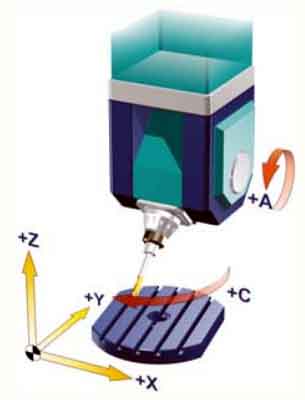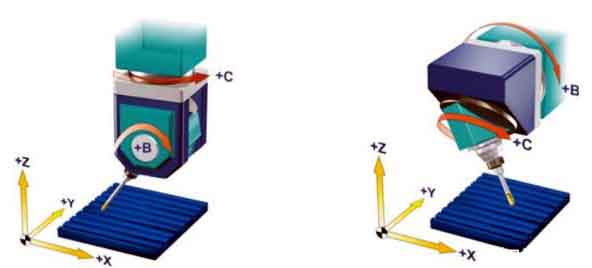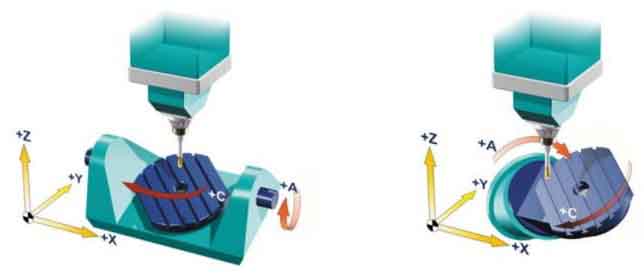Het is onethisch om dat te doen “over precisie gesproken zonder de daadwerkelijke CNC-bewerkingsmachine”. Als dat gezegd wordt “de precisie van een vijfassige CNC-werktuigmachine zal beslist hoger zijn dan die van een drieassige CNC-werktuigmachine”, dan staat het helemaal op papier. Het is heel goed mogelijk dat hoogwaardige drie-assige werktuigmachines een hogere bewerkingsnauwkeurigheidsindex hebben dan gewone vijf-assige werktuigmachines.
De 3-assige werktuigmachine bevat drie lineaire assen, X, Y, en Z, and its structure is relatively simple. During the processing of the 3-axis machining center, the direction of the tool axis will not change, the motion mode is also limited, and the programming is relatively simple.
On the surface, a 5-axis machine tool has two more rotation axes than a three-axis machine tool. Dat is, in addition to the three linear axes of X, Y, en Z, a 5-axis machine tool also includes two of the A, B, and C rotation axes around the three linear axes of X, Y, and Z respectively. Mainly include the following combinations:

5-axis single turntable type – 5-axis single pendulum head type

5-as-draaikoptype (links) en 5-assig kantelbare draaibare kop (rechts)

5-axis swivel type (links) and 5-axis tilt swivel type (rechts)
De “5-axis tilting head” mentioned in the figure means that there is a rotating axis that is not perpendicular to the three linear axes, which is relatively rare. Its motion relationship is more complicated, but its structure is relatively compact, and its dynamic and static rigidity is better.
The difference between three-axis and five-axis is mainly reflected in the processing capacity. A five-axis machine tool can do the work of a three-axis machine tool, but the three-axis machine cannot complete the work of a five-axis machine tool. This shows that the existence of two rotating axes gives the five-axis machine tool stronger processing capabilities.
The advantages of the five-axis are mainly reflected in the following points:
1. Reduce the number of clamping. Due to the existence of two rotating shafts of the five-axis machine tool, the tool can approach the workpiece from any direction, and one clamping can realize the processing of all surfaces except the mounting surface. “Reduce the number of clamping times” can be described as two goals for the pursuit of high-efficiency and high-precision machining. Aan de ene kant, reducing the number of clamping times can save time, reduce the labor intensity of workers, and improve processing efficiency;
Aan de andere kant, it is possible to minimize possible errors caused by clamping and ensure processing accuracy.
2. Maintain the best cutting condition of the tool. Due to the use of a five-axis machine tool, the tool can approach the workpiece from any direction, so that the tool can cut the workpiece at the most appropriate angle. Het kan ook de verwerkingsefficiëntie en verwerkingskwaliteit verbeteren.
3. Vermijd effectief interferentie tussen gereedschappen. Ook vanwege het bestaan van twee roterende assen van een vijfassige werktuigmachine, the tool can approach the workpiece from any direction, waardoor het verwerkingstraject flexibel en veranderlijk wordt. Kan het interferentieprobleem in het verwerkingsproces effectief vermijden.
4. Verkort de ontwikkelingscyclus. Dit is ook het effect dat op natuurlijke wijze wordt bereikt nadat de kwaliteit en efficiëntie zijn verbeterd.
 English
English العربية
العربية 中文(漢字)
中文(漢字) Čeština
Čeština Dansk
Dansk Nederlands
Nederlands Suomi
Suomi Français
Français Deutsch
Deutsch Italiano
Italiano 日本語
日本語 ಕನ್ನಡ
ಕನ್ನಡ 한국어
한국어 Português
Português Русский
Русский Slovenčina
Slovenčina Español
Español Svenska
Svenska Türkçe
Türkçe

